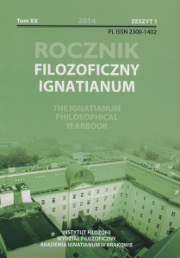O kłopotliwym problemie brakującej masy
Abstract
Poważną i kłopotliwą trudnością, która pojawiła się w fizyce końca XX wieku, jest kwestia brakującej masy. Naukowcy odkryli bowiem, że Wszechświat zawiera znacznie więcej materii niż dotychczas sądzono. Okazało się, że znane nam rodzaje materii stanowią tylko niewielką część całkowitej masy materii, z której zbudowany jest Wszechświat. Aby rozwiązać ten problem, należało znaleźć i zidentyfikować ową brakującą masę. Te poszukiwania doprowadziły fizyków do wysunięcia hipotezy o istnieniu tak zwanej ciemnej materii i ciemnej energii. W pierwszej części artykułu przytoczono argumenty przemawiające za istnieniem brakującej masy. W drugiej części omówiono hipotezy ciemnej materii i ciemnej energii, a w części trzeciej przedstawiono pewne alternatywne próby wyjaśnienia problemu brakującej masy. Na zakończenie poczyniono kilka uwag związanych z konsekwencjami tego „kłopotliwego problemu” dla przyszłego rozwoju nauki. Jedną z nich może być radykalna rewizja naukowego i filozoficznego obrazu świata.
Literaturhinweise
Adamson P (2011), "Measurement of the Neutrino Mass Splitting and Flavor Mixing by MINOS", Physical Review Letters. (106, arXiv:1103.0340v1 [hep-ex]), pp. 181801(1-6).
Ade PAR (2013), "Planck 2013 Results. Cosmological Parameters" (arXiv:1303.5076v1 [astro-ph.CO])
Babcock HW (1939), "The Rotation of the Andromeda Nebula", Lick Observatory Bulletin. (498), pp. 41-51.
Beckenstein JD (2004), "Relativistic Gravitation Theory for the Modified Newtonian Dynamics Paradigm", Physical Review D. (70), pp. 083509(1-28), arXiv:0403694v6 [astro-ph].
Bolejko K, Célérier MN and Krasiński A (2011), "Inhomogeneous Cosmological Models: Exact Solutions and their Applications", Classical and Quantum Gravity. (28), pp. 164002(1-30), arXiv:1102.1449v2 [astro-ph.CO].
Bolejko K, Krasiński A, Hellaby C and Célérier MN (2010), "Imitating Accelerated Expansion of the Universe by Matter Inhomogeneities --- Corrections of Some Misunderstandings", General Relativity and Gravitation. (42(10)), pp. 2453-2475.
Bosma A (1978), "The Distribution and Kinematics of Neutral Hydrogen in Spiral Galaxies of Various Morphological Types (PhD dissertation)" Groningen The University of Groningen.
Clarke AM (1903), "Problems in Astrophysics" London Adam and Charles Black.
Einstein A (1917), "Kosmologische Betrachtungen zur allgemeinen Relalivitätstheorie", Sitzungsberichte der Königlichen Preussischen Akademie der Wissenschaften. (1), pp. 142-152.
Glanz J (1998), "Astronomers See a Cosmic Antigravity Force at Work", Science. (279), pp. 1298-1299.
Jeans JH (1922), "The Motion of Stars in a Kapteyn Universe", Monthly Notices of the Royal Astronomical Society. (82), pp. 122-132.
Kragh H (2007), "Conceptions of Cosmos. From Myths to Accelerating Universe: A History of Cosmology" Oxford Oxford University Press.
Krasiński A (2009), "O modelach kosmologicznych i niektórych związanych z nimi nieporozumieniach", Postępy Fizyki. (60(3)), pp. 98-108.
Krasiński A (1997), "Inhomogeneous Cosmological Models" Cambridge Cambridge University Press.
Milgrom M (1983), "A Modification of the Newtonian Dynamics as a Possible Alternative to the Hidden Mass Hypothesis", The Astrophysical Journal. (270), pp. 365-370.
Moffat JW (2006), "Scalar-Tensor-Vector Gravity Theory", Journal of Cosmology and Astroparticle Physics. (03), pp. 004, arXiv:0506021v7 [gr-qc].
Oort JH (1932), "The Force Exerted by the Stellar System in the Direction Perpendicular to the Galactic Plane and Some Related Problems", Bulletin of the Astronomical Institutes of the Netherlands. (6), pp. 249-287.
Ostriker JP and Peebles PJE (1973), "A Numerical Study of the Stability of Flattened Galaxies: or, Can Cold Galaxies Survive?", The Astrophysical Journal. (186), pp. 467-480.
Ostriker JP, Peebles PJE and Yahil A (1974), "The Size and Mass of Galaxies, and the Mass of the Universe", The Astrophysical Journal. (193), pp. L1-L4.
Panek R (2011), "Ciemna strona Wszechświata. W poszukiwaniu brakujących składników rzeczywistości" Warszawa Prószyński i S-ka.
Peebles PJE and Ratra B (1988), "Cosmology with a Time-Variable Cosmological «Constant»", The Astrophysical Journal. (325), pp. L17-L20.
Riess G (1998), "Observational Evidence from Supernovae for an Accelerating Universe and a Cosmological Constant", The Astronomical Journal. (116(3), arXiv: 9805201 v1 [astro-ph]), pp. 1009-1038.
Roberts MS (1975), "The Rotation Curves of Galaxies", In Dynamics of Stellar Systems. Dordrecht , pp. 331-340. Reidel.
Rubin VC, Burley J, Kiasatpoor A, Klock B, Pease G, Rutscheidt E and Smith C (1962), "Kinematic Studies of Early-Type Stars, I: Photometric Survey, Space Motions, and Comparison with Radio Observations", Astronomical Journal. (67), pp. 491-531.
Rubin VC, Ford WK and Thonnard JN (1980), "Rotational Properties of 21 Sc Galaxies with a Large Range of Luminosity and Radii, from NGC 4605 (R = 4 kpc) to UGC 2885 (R = 122 kpc)", The Astrophysical Journal. (238), pp. 471-487.
Sciama DW (1993), "Modern Cosmology and the Dark Matter Problem" Cambridge Cambridge University Press.
Smith S (1936), "The Mass of the Virgo Cluster", The Astrophysical Journal. (83), pp. 23-30.
Taoso M, Bertone G and Masiero A (2008), "Dark Matter Candidates: A Ten-Point Test", Journal of Cosmology and Astroparticle Physics. (03, arXiv:0711.4996v2 [astro-ph])
Thomas SA, Abdalla FB and Lahav O (2010), "Upper Bound of 0.28 eV on Neutrino Masses from the Largest Photometric Redshift Survey", Physical Review Letters. (105(3), arXiv:0911.5291v2 [astro-ph.CO]), pp. 031301(1-4).
Tsujikawa S (2011), "Dark Energy: Investigation and Modeling", In Dark Matter and Dark Energy. A Challenge for Modern Cosmology. Dordrecht, New York , pp. 331-402. Springer.
Zwicky F (1933), "Die Rotveschiebung von extragalaktischen Nebeln", Helvetica Physica Acta. (6), pp. 110-127.
(2013), "Gravitational Lens", December, 2013.
(2010), "Particle Dark Matter: Observations, Models and Searches" Cambridge Cambridge University Press.
Rocznik przyjmuje do druku wyłącznie materiały, które nie wchodzą w żaden konflikt interesów, żaden konflikt z prawem autorskim itp. Redakcja prowadzi działania przeciw: plagiatom, ghostwriting1, guest/honorary authorship2 itp. Autor pracy zbiorowej, który jest pierwszy na liście, bierze na siebie odpowiedzialność i ma obowiązek przedstawić wkład wszystkich współautorów. Jeśli publikacja powstała dzięki dedykowanym środkom finansowym, należy ujawnić to np. w Podziękowaniu, przypisie itp. Ew. przedruki wymagają jawnego zgłoszenia i okazania odpowiedniego pozwolenia wydawniczego. Autorzy / Recenzenci nierzetelni narażają się na reakcję właściwą stosownym instytucjom.
______
1 Ma to miejsce, gdy osoba mająca istotny wkład jest pominięta na liście Autorów czy w Podziękowaniu.
2 Zachodzi, gdy na liście autorskiej pojawia się osoba mająca znikomy/żaden udział w pracy.





